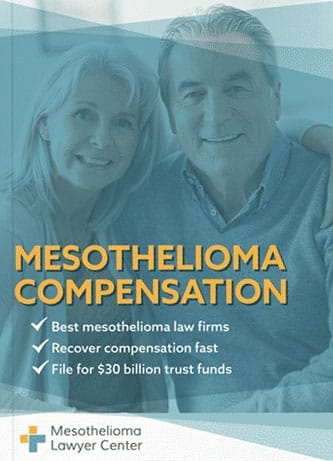Firefighters are at high risk for asbestos exposure and exposure to other toxins on the job. Firefighters routinely enter older buildings with exposed and deteriorating asbestos materials. Both current and retired firefighters are at risk of being diagnosed with mesothelioma and other asbestos diseases.
If you or a loved one have been diagnosed with mesothelioma, asbestosis, or asbestos-related lung cancer, you may be eligible for substantial compensation. Fill out our form to receive our free Financial Compensation Packet. Our packet is loaded with information on experienced mesothelioma attorneys in your area, how to file a claim for asbestos trust funds, how to get paid in 90 days, and more.


FREE Financial Compensation Packet
- Info on law firms that will recover your HIGHEST COMPENSATION
- Learn how to get paid in 90 days
- File for your share of $30 billion in trust funds
How Firefighters Are Exposed to Asbestos
Firefighters have a high risk of asbestos exposure. Asbestos is no longer used as heavily as in the past, but it is not banned. Asbestos can still be found in many products and materials.
When asbestos materials are disturbed, they release fibers. These tiny fibers become part of the dust and debris in the air, and anyone in the area can inhale them.
Inhaled asbestos fibers cause damage inside the body, leading to mesothelioma, asbetosis, and several cancers. Repeated and prolonged asbestos exposure is more likely to cause illnesses decades later. Firefighters are at risk for this in several ways.
Asbestos Construction Materials
When firefighters enter burning buildings, they face a lot of debris, which is toxic. Older buildings often contain asbestos. Fire destroys asbestos materials and releases fibers into the air.
Before the construction agency phased it out, asbestos was used in hundreds of products that went into residential, commercial, and industrial buildings:
- Vinyl flooring
- Flooring adhesive
- Roofing
- Siding materials
- Shingles
- Insulation
- Ceiling tiles
- Furnaces
- Wood-burning stoves
- Boilers
- Pipes
- Joint compound
- Textured paints and finishes
- Soundproofing and fireproofing materials
Asbestos in Protective Gear
In addition to exposure to asbestos from burning buildings, firefighters in the past wore protective clothing that was also made of asbestos. Asbestos is an effective insulator and fireproofing material. It was used extensively in protective gear before the health risks were widely known.
From the early 1900s until the late 1970s, firefighter gear and clothing, including helmets, boots, jackets, and coats, contained asbestos.
Asbestos in Fire Stations
Fire stations in the past were also built with asbestos-containing products. Firefighters who spent time in these stations, especially those who helped make repairs or do maintenance, risked inhaling asbestos fibers.
Firefighters working today remain at risk of exposure to asbestos in old fire station buildings. If the asbestos materials in the buildings are not maintained, they can deteriorate and release harmful fibers.
Firefighters and Asbestos Exposure on 9/11
Firefighters and other first responders face exposure risks whenever an older building with asbestos materials is destroyed. A massive example of this risk occurred on 9/11 when the Twin Towers came down, releasing tons of harmful toxins.
This was a rare example of first responders being exposed to vast amounts of asbestos at one time. According to studies, about 1% of the dust released on 9/11 was asbestos. Because of the huge quantity of dust, this amounted to tons of asbestos fibers in the air.
The High Risk of Asbestos Exposure in Firefighters
The Centers for Disease Control and Prevention (CDC) reports that a multi-year study was performed between 1987 and 2003 by the United States Fire Administration (USFA) and the National Institute for Occupational Safety and Health (NIOSH).
The study examined the risks firefighters have of developing cancer due to exposure to smoke, soot, asbestos, fumes, and other toxins that are a part of a firefighter’s job.
According to the study, which included more than 18,000 former and current firefighters, there is a strong chance of firefighters developing asbestos-related illnesses. These include malignant mesothelioma, asbestosis, and asbestos-related lung cancer.
A study from 2013 reported on the incidence of all types of cancer in firefighters. Respiratory cancers were the most common. The study found that firefighters had mesothelioma diagnoses at a rate two times greater than that of the general population.
Firefighters Have High Risk of Dying from Cancer
Asbestos is the only known cause of mesothelioma, which firefighters are diagnosed with at unusually high rates. Studies also indicate that firefighters have higher rates of cancer overall. They are more likely to die of cancer as compared to the general population.
In fact, cancer is often the leading cause of death in firefighters. The International Association of Fire Fighters reported that cancer was the cause of death for 74% of firefighters who passed away in 2022.
The statistic reflects the harmful chemicals firefighters are exposed to on the job. Asbestos is just one of these. The International Agency on the Research of Cancer listed the act of firefighting as a group one carcinogen.
Legal Actions and Fines for Asbestos Exposure in Firefighters
Numerous firefighters have sued the manufacturers who supplied asbestos-containing products to homes and buildings. Many firefighters have even sued the city in which the asbestos exposure occurred.
For example, in 2007, several firefighters in Everett, Washington, were exposed to asbestos during training exercises.
The building where the training took place contained significant amounts of asbestos. Court records indicate that a fire official knew of the asbestos yet didn’t move the training to another place nor offer any protective gear during the training period.
The firefighters sued the city of Everett in 2011 and won a settlement. The settlement covers lifetime health monitoring for the individuals exposed.
Firefighters Push for Total Asbestos Ban
Regulations have limited asbestos use, but there is no total asbestos ban in the U.S. Asbestos affects many people, but firefighters are disproportionately harmed. For this reason, the International Association of Fire Fighters (IAFF) advocates for an asbestos ban.
According to the IAFF, firefighters are 200 times more likely to develop an asbestos disease than other people. In a recent statement, the IAFF cited a recent incident in Richmond, Indiana. An old warehouse burned, releasing asbestos. The firefighters on the scene spent days fighting it and risking exposure.
The IAFF supports the Alan Reinstein Ban Asbestos Now Act, which would ban importing, using, and selling asbestos in the U.S.
Safety and Prevention for Current Firefighters
Although asbestos is no longer used in fire stations and protective clothing, firefighters risk of inhaling asbestos while on the job.
There are several things that firefighters can do to protect themselves as much as possible when working around asbestos:
- Remove all work clothes and wash them as soon as possible.
- Always wear a regulation respirator when working; ordinary dust masks will not prevent you from ingesting or inhaling asbestos.
- When working after a fire, make sure the area is wetted down thoroughly.
- Make sure to leave all work gear in the same storage place, thoroughly washed.
- Take a hot shower as soon as possible after work.
- When washing work gear, ensure it’s in a washer specifically for asbestos clothing and gear only.
- Never bring gear home that could contain any toxic materials.
- Request regular cancer screenings. Early cancer diagnoses save lives.
When called to an emergency, it’s often hard to discern where asbestos is located. In most instances, firefighters don’t have the time to stop and check.
Wearing the proper protective equipment is extremely important as it can help save lives when working in a building or home with asbestos.
Asbestos Compensation for Firefighters
If you worked as a firefighter, discuss asbestos screenings with your doctors. Contact a mesothelioma lawyer if you get sick. They can help you seek compensation through asbestos trust funds or lawsuits.
The September 11th Victim Compensation Fund provides benefits for individuals present at the sites of the 9/11 terrorist actions who developed related illnesses. This includes asbestos-related illnesses. The program was permanently authorized in 2019, so victims can still seek compensation.
Additional Help and Resources for Firefighters
If you’ve been injured by mesothelioma, asbestosis, or asbestos-related cancer, keep in mind that there is a good chance that you’ll qualify for considerable compensation. Remember to fill out the form for your free Financial Compensation Packet, with information on asbestos and mesothelioma lawyers in your area. If you have questions or need additional assistance, contact us at 800-793-4540.

Paul Danziger
Reviewer and EditorPaul Danziger grew up in Houston, Texas and earned a law degree from Northwestern University School of Law in Chicago. For over 25 years years he has focused on representing mesothelioma cancer victims and others hurt by asbestos exposure. Paul and his law firm have represented thousands of people diagnosed with mesothelioma, asbestosis, and lung cancer, recovering significant compensation for injured clients. Every client is extremely important to Paul and he will take every call from clients who want to speak with him. Paul and his law firm handle mesothelioma cases throughout the United States.
References
- International Fire Fighter. (2020, April 3). Asbestos Risks for Firefighters.
Retrieved from: https://iffmag.mdmpublishing.com/asbestos-risks-for-firefighters/ - National Fire Protection Association. (n.d.). Firefighters and Cancer.
Retrieved from: https://www.nfpa.org/education-and-research/emergency-response/firefighters-and-cancer - Smith, D. (2011, December 22). Everett Settles Firefighters’ Lawsuit Over Asbestos Exposure. Everett Herald.
Retrieved from: http://www.heraldnet.com/article/20111223/NEWS01/712239906 - Landrigan, P.J., Lioy, P.J., Thurston, G., Berkowitz, G., Chen, L.C., Chillrud, S.N., Gavett, S.H., Georgopoulos, P.G., Geyh, A.S., Levin, S., Perera, F., Rappaport, S. M. & Small, C. (2004). Health and Environmental Consequences of the World Trade Center Disaster. Environ. Health Perspect., 112(6), 731-9.
Retrieved from: https://cfpub.epa.gov/ncer_abstracts/index.cfm/fuseaction/display.files/fileID/13298 - Bachara, G. (2023, January 2). Cancer Now Leading Cause of Death Among Firefighters, International Association of Fire Fighters Says. WDJT.
Retrieved from: https://www.cbs58.com/news/cancer-now-leading-cause-of-death-among-fire-fighters-international-association-of-fire-fighters-says - September 11th Victim Compensation Fund. (n.d.). Welcome to the VCF.
Retrieved from: https://www.vcf.gov/ - International Association of Fire Fighters. (2023, August 15). IAFF Supports a Nationwide Asbestos Ban.
Retrieved from: https://www.iaff.org/news/iaff-supports-a-nationwide-asbestos-ban/
